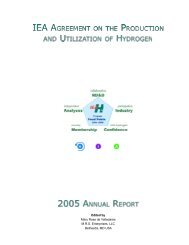Technology Status of Hydrogen Road Vehicles
Technology Status of Hydrogen Road Vehicles
Technology Status of Hydrogen Road Vehicles
You also want an ePaper? Increase the reach of your titles
YUMPU automatically turns print PDFs into web optimized ePapers that Google loves.
Wetzel (1996) gives a comprehensive summary <strong>of</strong> the special facility operating in Germany since 1991,<br />
dedicated to the improvement <strong>of</strong> LH 2 handling at refueling stations. All operations in the three main refueling<br />
phases (connect--cool down, filling proper, depressurize--disconnect) are automatic, except the relatively<br />
simple ones <strong>of</strong> connect and disconnect. Total refueling times are now down to 8.6 or 5.2 minutes depending<br />
on the coupling used, and LH 2 releases (which are largely recuperable) are correspondingly down to 14.2 or<br />
8.0 liters, respectively. These improvements are valid for the BMW test car (Item 1 Table 1) which was<br />
frequently refueled at the facility. Hettinger et al. (1996) describe more qualitatively a mobile filling station<br />
for refueling cars and buses with LH 2.<br />
Yamane and Furuhama (1996) is a parameter study concerning on-board hydrogen storage, showing the effect<br />
<strong>of</strong> total weight <strong>of</strong> fuel and fuel tank on the main parameters that affect car performance; it concludes by stating<br />
that only LH 2 <strong>of</strong>fers the accustomed performance.<br />
4.0 Vehicle Power Units and Drives<br />
When conventional vehicles were introduced at the end <strong>of</strong> the last century, several approaches to the<br />
fundamental choices <strong>of</strong> engine and drive were taken, but the winner--the ICE with geared drive--quickly<br />
emerged and has remained dominant for most <strong>of</strong> this century. This is not likely to happen with hydrogen<br />
vehicles in the foreseeable future.<br />
As discussed, the choice <strong>of</strong> fuel storage has a strong influence on system layout, and can directly affect the<br />
choice <strong>of</strong> prime mover. For example, only LH 2 today seems capable <strong>of</strong> giving a hydrogen ICE a range<br />
comparable to conventional fuels, at least for cars with limited space; on the other hand, an FC with its much<br />
higher efficiency confers greater flexibility on the choice <strong>of</strong> fuel storage.<br />
More fundamentally, enough progress has been made during the past 5 years to reinforce the conviction,<br />
already tentative in DeLuchi’s 1989 report, that FCs are a more natural partner for hydrogen in whatever form,<br />
and possess the potential <strong>of</strong> lower life-cycle costs than the ICE. It is still too early for definite conclusions,<br />
and indeed there is good reason to think that the ICE and a successful FC can coexist for many decades.<br />
The proliferation underway in prime mover research, development, and demonstration can be conveniently<br />
grouped in three broad categories:<br />
! The ICE, usually reciprocating but including the rotary version<br />
! FCs, especially the two types most indicated today for mobile applications<br />
! Hybrids, which re-dimension the prime mover (ICE or FC) size down to average running loads, and cover<br />
transients with energy-storage devices such as batteries, capacitors, or flywheels.<br />
A fourth category could include more speculative concepts; e.g., the external combustion engine--the Stirling<br />
engine is being re-examined because <strong>of</strong> its adaptability to H 2. They are not included because <strong>of</strong> lack <strong>of</strong><br />
information.<br />
Lund (1996) illustrates an innovative type <strong>of</strong> hydrogen vehicle that is emerging from the classic electric<br />
vehicle. Instead <strong>of</strong> traditional lead-acid batteries, Toyota and Panasonic envision upgrading their innovative<br />
Ni-metal hydride batteries to vehicle size, thereby improving energy density and reducing vehicle weight.<br />
4.1 Internal Combustion Engines<br />
The ICE is highly optimized for conventional fuels, but is an awkward partner for hydrogen. This is surprising<br />
at first glance, perhaps because <strong>of</strong> hydrogen’s excellent combustion characteristics. The problem is that the<br />
7













